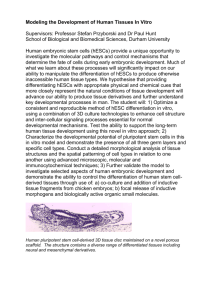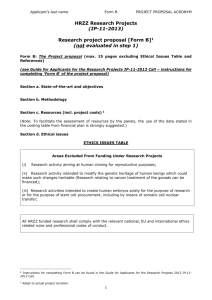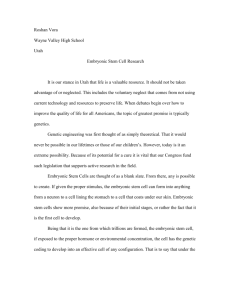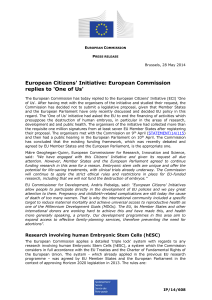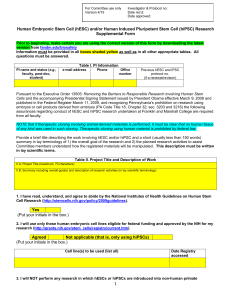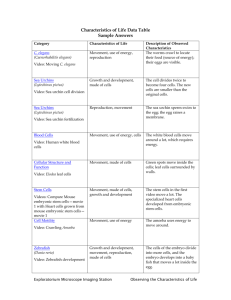Lab 2 - hESC Culture - Workforce Development in Stem Cell Research
advertisement
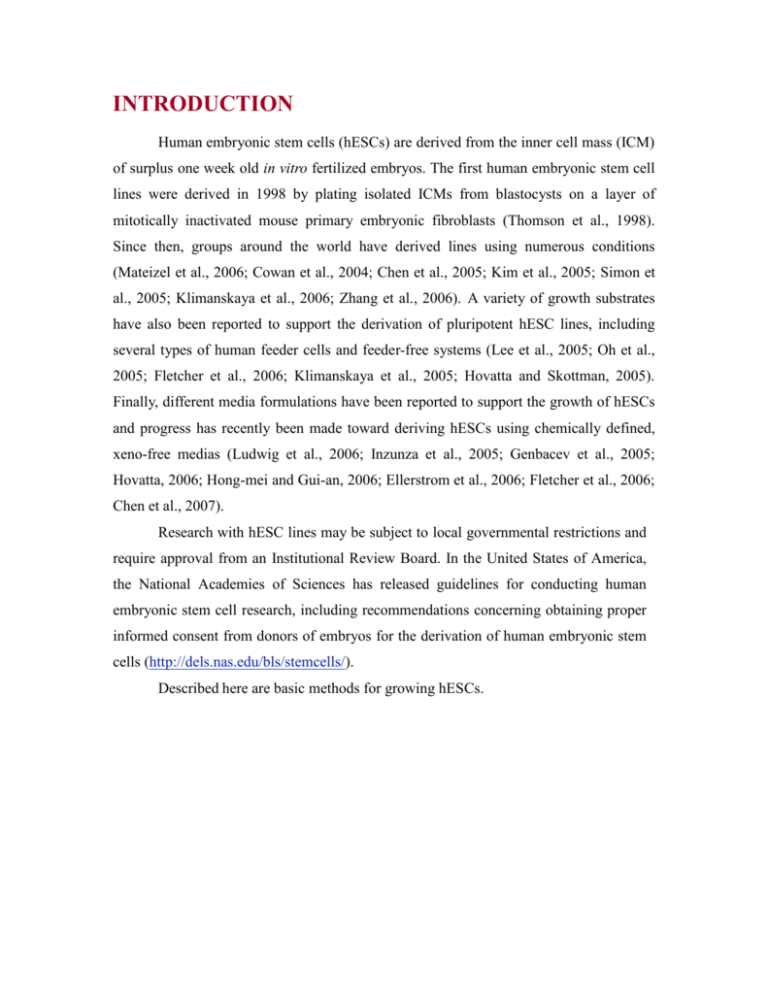
INTRODUCTION Human embryonic stem cells (hESCs) are derived from the inner cell mass (ICM) of surplus one week old in vitro fertilized embryos. The first human embryonic stem cell lines were derived in 1998 by plating isolated ICMs from blastocysts on a layer of mitotically inactivated mouse primary embryonic fibroblasts (Thomson et al., 1998). Since then, groups around the world have derived lines using numerous conditions (Mateizel et al., 2006; Cowan et al., 2004; Chen et al., 2005; Kim et al., 2005; Simon et al., 2005; Klimanskaya et al., 2006; Zhang et al., 2006). A variety of growth substrates have also been reported to support the derivation of pluripotent hESC lines, including several types of human feeder cells and feeder-free systems (Lee et al., 2005; Oh et al., 2005; Fletcher et al., 2006; Klimanskaya et al., 2005; Hovatta and Skottman, 2005). Finally, different media formulations have been reported to support the growth of hESCs and progress has recently been made toward deriving hESCs using chemically defined, xeno-free medias (Ludwig et al., 2006; Inzunza et al., 2005; Genbacev et al., 2005; Hovatta, 2006; Hong-mei and Gui-an, 2006; Ellerstrom et al., 2006; Fletcher et al., 2006; Chen et al., 2007). Research with hESC lines may be subject to local governmental restrictions and require approval from an Institutional Review Board. In the United States of America, the National Academies of Sciences has released guidelines for conducting human embryonic stem cell research, including recommendations concerning obtaining proper informed consent from donors of embryos for the derivation of human embryonic stem cells (http://dels.nas.edu/bls/stemcells/). Described here are basic methods for growing hESCs. FEEDER PREPARATION Preparing Primary Mouse Embryonic Fibroblasts (MEFs) On the bench: Observe clean and sterile tissue technique. Sterilize all instruments needed for the surgery. 1. Sacrifice pregnant females 12 days after the morning the vaginal plugs were observed (E12.5). 2. Swab the abdomen with 70% ethanol. 3. Grasp the skin of the abdomen with forceps and make a large incision through the skin with scissors. 4. Grasp the body wall (peritoneum) with fine forceps and make an incision with scissors. 5. Remove the uterus with blunt forceps. 6. Embryos can be released from the uterus by inserting the tip of fine tipped scissors into the anterior end of one of the uterine horns, then cutting along the length of the uterus. 7. Release each embryo and place them into a 10cm dish with 1xPBS. 8. Remove the yolk sac and placenta and place the embryo into a new 10cm dish with PBS. 9. Remove the head and the intestines with forceps (all the red parts of the embryos) and place into a new 10cm dish with PBS. This dish is still unsterile. Cut off anterior half of embryo. Gently remove intestines (red). (Cebra-Thomas., 2002) 10. Using forceps, transfer the embryos from the unsterile dish to a new, sterile dish under a laminar flow hood. When transferring, make sure the forceps do not touch the contents of the sterile dish. Under the hood: Observe sterile technique. 11. Wash 2 times with PBS by transferring each embryo from the same litter from one 1xPBS dish to a new dish with sterile 1xPBS. Make sure the forceps do not touch the contents of the dish to which you are transferring, in order to go from “clean” to “cleaner.” 12. Transfer the embryos to a new 10cm dish with 5ml of 0.5% Trypsin-EDTA. 13. Mince the embryos with sterilized scissors. 14. Leave the 5ml trypsin/ minced embryos dish tilted into the 37°C incubator for a 5 minute incubation. . 15. Bring the dish back under the hood and pipette vigorously to disperse the cells. 16. Add fibroblast media (MEF media, see Appendix 2) to neutralize the trypsin. Plate approximately 2 embryos per T175 flask. If desired, the largest clumps of tissue can be settled out in a 50ml conical tube prior to plating. 17. Change the media the day after plating. Incubate flasks until confluent, usually 12 days. 18. When the T175 are confluent, split MEFs (see Passaging Feeders) or freeze down 2 vials per T175 (see Freezing Feeders), which would be passage 1. Passaging Feeders Once the MEFs are confluent, they either need to be split for expanding or frozen down. For either, start by removing the cells from the flasks. 1. Remove media from flasks and wash with PBS to remove all traces of FBS. 2. Trypsinize the cells: Add enough trypsin to cover the bottom of the flask (5-7ml in a T175 flask). Incubate for ~5 minutes. Check the cells under a microscope to make sure they are all detached. Inactivate the trypsin by adding media containing FBS (at least the same volume as the trypsin originally added). 3. Transfer the contents of the flask to a tube to spin down. 4. Spin at 1000 rpm for 5 minutes. 5. Aspirate supernatant, resuspend in MEF media and move to new flask. MEFs are commonly split in 1:3 to 1:5 ratios. Freezing Feeders Feeders can be cryopreserved in liquid nitrogen after slow freezing in isopropanolcontaining jars. We routinely use 90% FBS/10% DMSO as the freezing media. 1. Trypsinize the cells (see Passaging Feeders). 2. Spin down. 3. Remove supernatant and resuspend the cell pellet in freezing media (see Appendix 2). 4. Freeze 2 vials of cells per flask, 1ml per vial. Mitotically Inactivating Feeders If feeders are used, they must be mitotically inactivated either by treating with mitomycin C or by irradiation. We have successfully derived hESC lines using both irradiated human foreskin fibroblasts (ATCC) and mitomycin C treated E12.5 primary embryonic fibroblast from CF1 mice (Charles River). Prior to mitotically inactivating the cells, we typically expand the cells to the largest number of flasks we can manage, typically around 36-48 T175 flasks per person performing the prep. In addition, we try to inactivate primary mouse embryonic fibroblasts by passage 4 or 5. Therefore, for a routine prep, we would thaw 2 vials of primary mouse embryonic fibroblasts into 2 T175 flask (P1), pass 1:3 to 6 flasks (P2), pass 1:3 to 18 flasks (P3), then pass 1:3 into 54 flasks (P4) and then pass 1:3 into 162 flasks (P5). We grow the cells in media containing antibiotics for the first two passages and switch to antibiotic-free media upon the third passage. Although gelatin coating is always advisable when inactive MEFs are plated (in order to promote adhesion of the cells to the culture dishes), growing MEFs DO NOT require it. » Inactivation with Mitomycin C 1. 2. 3. 4. 5. 6. 7. 8. 9. Remove media from a confluent flask or dish of cells. Add 10ug/ml Mitomycin C in media to the cells (see Appendix 2). Incubate 2.5 hours. Wash with 2xPBS. Trypsinize the cells (see Passaging Feeders). Spin down. Repeat step #7 two times. Resuspend in media and count the cells. Spin down. Resuspend the cells in freezing media at a convenient density (we usually freeze the cells into aliquots containing 0.5, 1.5, 4.5 and 9 x 106 cells). 10. Aliquot the cells into cryovials and freeze (see Freezing Feeders). » Inactivation by Irradiation 1. 2. 3. 4. 5. 6. Wash with 1xPBS. Trypsinize the cells (see Passaging Feeders). Irradiate the cells to 6000 rads. Count the cells. Spin down. Resuspend the cells in freezing media at a convenient density (see #10 above). Aliquot the cells into cryovials and freeze (see Freezing Feeders). Thawing Feeders 1. Fill a 15ml conical tube with ~10ml of MEF media (see Appendix 2). 2. Place the vial of frozen feeders in a 37ºC water bath. When only a thin piece of ice remains in the vial, remove the vial from the water bath. 3. Resuspend the MEFs in ~1ml of MEF media. (Release only a few drops of the MEF media at a time. Use the pipette tip to gently stir the contents of the vial.) 4. Transfer resuspended MEFs from vial to the 15ml conical tube. 5. Pellet the cells in a conical tube at ~1000 rpm for 3-5 minutes. 6. Remove supernatant. Resuspend the cells in the desired volume and transfer to a cell culture dish (previously gelatinized). The MEFs should be inactive. Plating Feeders to Support hESC Growth Approximate Feeder Plating Densities Format Area (per well) Minimum (2x104 cells/cm2) Optimal (2.5x104 cells/cm2) Maximum (3x104 cells/cm2) For conditioned media (5.6x104 cells/cm2) 35 mm dish 8 1.6x105 2.0x105 2.4x105 4.5x105 60 mm dish 21 4.2x105 5.3x105 6.3x105 1.2x106 10 cm dish 56 1.1x106 1.4x106 1.7x106 3.1x106 T-25 flask 25 5.0x105 6.3 x105 7.5x105 1.4x106 T-75 flask 75 1.5x106 1.9x106 2.3x106 4.2x106 24-well plate 2 4.0x104 5.0x104 6.0x104 12-well plate 4 8.0x104 1.0x105 1.2x105 6-well plate 9.5 1.9x105 2.4x105 2.9x105 1. Gelatinize tissue culture grade dishes with 0.25% gelatin for 30 minutes. 2. Thaw a vial of mitotically inactivated feeders and resuspend in at least 5 volumes of feeder media. 3. Pellet the cells in a conical tube at ~1000 rpm for 3-5 minutes. 4. Remove supernatant. Resuspend the cells and plate at a density between between 2x104 to 3x104 cells per cm2 (see table above). 5. Incubate the feeder cells overnight before plating hESCs. 6. Prior to plating hESCs (at least 30 minutes before, but up to 6 hours prior), remove feeder media. Wash two times with 1xPBS. Then add hESC media. hESC CULTURE Growing hESCs in Feeder-Free Conditions » Growth in Chemically Defined, Feeder-Free Media All steps described in the following are specific for hESC culture under feeder-free conditions in chemically defined media. Day1: Thawing hESCs 1. Fill a 15ml conical tube with ~10ml of mTeSR1 media (see Appendix 2). 2. Place the vial of frozen hESCs in a 37ºC water bath. When only a thin piece of ice remains in the vial, remove the vial from the water bath. 3. Slowly resuspend the hESCs in ~1ml of mTeSR1 media. (Release only a few drops of the mTeSR1 media at a time. Use the pipette tip to gently stir the contents of the vial.) 4. Transfer resuspended hESCs from vial to the 15ml conical tube. 5. Pellet the cells in a conical tube at ~1000 rpm for 3-5 minutes. 6. Remove supernatant. Slowly resuspend the cells in the desired volume. Plating hESCs 1. 2. 3. 4. Be sure to prepare culture plates coated with matrigel Bake matrigel coated plates in incubator for at least 30 minutes Aspirate matrigel and wash once with 1xPBS Plate hESCs (resuspended in mTeSR1 media) in appropriate media What to Expect As the hESC lines begin to expand, spontaneous differentiation will be observed. Undifferentiated hESC colonies have clearly defined borders, with uniform, tightly packed cells that exhibit a shiny, refractory morphology under the phase contrast microscope. Under higher power, hESCs have a high nucleus to cytoplasm ration with prominent nucleoli. If the number of differentiated colonies becomes greater than approximately 40% of the total colonies, they should be removed by aspiration. If the number of undifferentiated colonies becomes extremely low compared to differentiated colonies, the undifferentiated colonies can be individually dissected out and plated into a smaller dish. In general, hESCs are more difficult to grow in synthetic media when compared to standard hESC media, exhibiting a higher rate of spontaneous differentiation. Recovery rates following the first cryopreservation can be extremely low. If only a few small colonies are visible one week after thawing, additional feeders can be plated onto the existing culture to allow further growth of the hESCs (not in feeder-free conditions). Passaging hESCs Approximately once per week, between 4-8 days, hESC colonies are passed either mechanically or enzymatically to fresh plates of feeders or matrigel. Colonies can be mechanically dissected using borosilicate Pasteur pipettes that have been pulled into fine needles and blunted over a flame. Mechanical passage is best performed within a laminar flow hood outfitted with a dissection microscope (stereomicroscope). » Mechanical Passage 1. Heat the middle of a sterile borosilicate Pasteur pipette over a flame. Stretch the pipette so it forms a narrow bore where heated. 2. Bend the pipette, snapping the glass where it narrows, so that the end creates a needle with a fine point. Polish the end of the needle over a flame. 3. Using either a single needle or a pair of needles, cut the colonies into approximately 2 to 4 pieces. 4. Transfer dissected colonies to a new plate with fresh feeders. » Enzymatic Passage hESCs have been successfully passaged with collagenase, dispase, trypsin and TrypLE. When we pass the cells enzymatically, we routinely use collagenase as described below for hESCs on feeders and dispase or accutase for hESCs on matrigel. Described here is the passaging on feeder-free conditions with accutase. 1. 2. 3. 4. 5. 6. 7. Remove the old media. Wash cells once in mTeSR1 media. Add accutase: 1 ml per well (6well format). Incubate at 37 C for 2-4 min (depending on cell line). Cells should be lifting up and colonies loosening out, check under microscope. Dilute/Neutralize accutase by adding 1 ml warm mTeSR1 media. Pipette with P1000 carefully to release cells from dish and transfer to 15 ml conical (use scraper also). 8. If cells are left in the dish, wash with mTeSR1 media to collect those cells and transfer to 15 ml conical. 9. Centrifuge at 1000 rpm, 4 minutes to pellet cells. 10. Resuspend in fresh mTeSR1 media and distribute to new plate (see Plating hESCs). 11. Shake well to distribute, check under scope to see how cells look. 12. IMPORTANT: if passaging cells with accutase to a new plate, make sure to add Thaizovivin at 1:5000 dilution in mTeSR1 (this allows for better attachment and survival of single cells). Freezing hESCs hESCs can be cryopreserved in liquid nitrogen using slow freezing. We routinely use 90% FBS + 10% DMSO (see Appendix 2) as the freezing media or more recently, we have successfully utilized BAMBANKER, a serum-free freezing medium (sold by Wako). We have also successfully substituted human serum albumin for FBS. When hESCs are dissociated in preparation for cryopreservation, we try to maintain the average size of the colonies larger than when we passage the colonies. The recovery rate of hESCs following cryopreservation is low. Therefore, we freeze down cells at a high concentration and thaw at a high density. For master stocks, we freeze one 10cm dish into three vials and thaw each vial into a single 60mm dish. 1. 2. 3. 4. 5. 6. 7. Remove the old media. Wash cells once in mTeSR1 media. Add accutase: 1 ml per well (6well format). Incubate at 37 C for 2-4 min (depending on cell line). Cells should be lifting up and colonies loosening out, check under microscope. Dilute/Neutralize accutase by adding 1 ml warm mTeSR1 media. Pipette with P1000 carefully to release cells from dish and transfer to 15 ml conical (use scraper also). 8. If cells are left in the dish, wash with mTeSR1 media to collect those cells and transfer to 15 ml conical. 9. Centrifuge at 1000 rpm, 4 minutes to pellet cells. 10. Resuspend in Bambanker freezing medium and transfer to cryovial (750ul). Day 2: Observe and evaluate passaged hESCs Observe and evaluate thawed hESCs Students will focus on the hESC culture section during the lab sessions. The rest of the protocol is additional information and useful to understand the basics of hESC culture in both, feeder-free and feeder-based culturing. Appendix 1: MATERIALS LIST Reagents *Invitrogen has different catalog numbers for single bottles and cases. REAGENT ALSO KNOWN MANUFACTURER AS Basic Fibroblast Growth FGF-basic, FGF-b, Invitrogen Factor FGF-2, bFGF BAMBANKER Freezing Lymphotec Media (sold by Wako) 55mM βInvitrogen Betamercaptoethanol mercaptoethanol, (1000x) β-ME, BME, 2mercaptoethanol, 2-ME Collagenase, Type IV Invitrogen Dimethyl sulfoxide DMSO Sigma DMEM with GlutaMAX KODMEM:F12, KODMEM/F12 FBS Knockout Serum Replacer KOSR, KO-SR, KSR Matrigel, Growth Factor Reduced Mitomycin C mTeSR1 302-14681 (120ml) 21985-023 (50ml) Invitrogen Invitrogen 26140-079 (500ml) ATCC SCRC-1041 Sigma Invitrogen Invitrogen G1890 25030-081 (100ml) 25030-164 (20x100ml) 10828-028 (500ml) BD Biosciences 354230 (10ml) M4287-2MG (2mg) 05850 (1kit) 10mM MEM Non-Essential Amino Acids (100x) NEAA Sigma STEMCELL Technologies Invitrogen Phosphate Buffered Saline (1x) PBS Invitrogen Penicillin/Streptomycin (100x) Pen/Strep, P/S Invitrogen Trypsin-EDTA, 0.05% MMC PHG0263 (1mg) 17104-019 (1g) D2438 (50ml OR 5x10ml) 10569-010 (500ml) 10569-044 (10x500ml) 12660-012 (500ml) Invitrogen Knockout DMEM:F12 medium Fetal Bovine Serum, Qualified Human Foreskin Fibroblasts Gelatin Powder 200mM L-Glutamine (100x) CATALOG # Invitrogen 11140-050 (100ml) 11140-076 (20x100ml) 10010-023 (500ml) 10010-049 (10x500ml) 15140-122 (100ml) 15140-163 (20x100ml) 25300-062 (500ml) Supplies EQUIPMENT Cell Scraper Cryo 1°C Freezing Container 0.22um Sterile Filter (250ml bottle) 0.22um Sterile Filter (500ml bottle) T175 Flasks 60mm Ultra-Low Adhesion Culture Dish MANUFACTURER BD Falcon Nalgene Millipore CATALOG # 353085 (case of 100) 5100-0001 SCGPU02RE (case of 12) Millipore SCGPU05RE (case of 12) BD Biosciences Corning 353112 (case of 40) 3261 (case of 20) Appendix 2: MEDIA PREPARATION MEF Media Recipe: 90% DMEM + 10% FBS + P/S Preparation: Filter reagents through a 0.2um sterile filter unit. (For the purposes of this course, we will add FBS and P/S to the original 500ml bottle of DMEM.) 250ml MEF Media REAGENT DMEM with GlutaMAX FBS 100x Pen/Strep VOLUME 225ml 25ml 2.5ml STOCK WORKING CONC. 90% 10% hESC Media Several hESC media variations based on Thomson’s original recipe have been reported to successfully support the growth of hESCs (Thomson et al., 1998; Genbacev et al., 2005; Inzunza et al., 2005; Hong-mei and Gui-an, 2006). Most use Knockout Serum Replacement from Invitrogen and FGF-2 (basic FGF). Our standard hESC Media recipe, “W8,” is a modification of the media recommended by WiCell, “W4,” (http://www.wicell.org) with twice as much FGF-2 (8ng/ml vs. 4ng/ml). Since Knockout Serum Replacement contains bovine serum albumin, efforts have been made to develop completely xeno-free media for growing hESCs. Recently, xeno-free, chemically defined media has been used to derive hESCs (Ludwig et al., 2006). » W8 Media Recipe: (see below) Preparation: Filter sterilize media through a 0.2um filter unit. Thaw KOSR immediately before use and be careful not to re-treat repeatedly as KOSR is heat-sensitive. 250ml W8 Media REAGENT Knockout DMEM:F12 KOSR 100x Glutamine 100x NEAA 100x Pen/Strep β-ME FGF-2 VOLUME 192.5ml 50ml 2.5ml 2.5ml 2.5ml 455ul 200ul STOCK WORKING CONC. 200mM 10mM 20% 1% 1% 1% 55mM 10ug/ml 8ng/ml Varying Volumes W8 Media REAGENT KODMEM:F12 KOSR GLUTAMINE NEAA PEN/STREP β-ME (*uL) FGF-2 (*uL) VOLUME (*mL unless otherwise noted) 50 100 150 200 250 300 mL mL mL mL mL mL 350 mL 400 mL 450 mL 500 mL 650 mL 38.5 10 0.5 0.5 0.5 91 40 269.5 70 3.5 3.5 3.5 637 280 308 80 4 4 4 728 320 346.5 90 4.5 4.5 4.5 819 360 385 100 5 5 5 910 400 500.5 130 6.5 6.5 6.5 1183 520 77 20 1 1 1 182 80 115.5 30 1.5 1.5 1.5 273 120 154 40 2 2 2 364 160 192.5 50 2.5 2.5 2.5 455 200 231 60 3 3 3 546 240 » W4 Media Recipe: (see below) Preparation: Filter sterilize media through a 0.2um filter unit. Thaw KOSR immediately before use and be careful not to re-treat repeatedly as KOSR is heat-sensitive. 250ml W4 Media REAGENT Knockout DMEM:F12 KOSR 100x Glutamine 100x NEAA 100x Pen/Strep β-ME FGF-2 VOLUME 192.5ml 50ml 2.5ml 2.5ml 2.5ml 455ul 100ul Freezing Media Recipe: 90% FBS + 10% DMSO Preparation: Filter sterilize media. STOCK WORKING CONC. 200mM 10mM 20% 1% 1% 1% 55mM 10ug/ml 4ng/ml 50ml Freezing Media REAGENT FBS DMSO VOLUME 45ml 5ml STOCK WORKING CONC. 90% 10% Mitomycin C Solution Recipe: 10ug/ml Mitomycin C in media Preparation: Standard bottle will make 200ml Mitomycin C solution. Filter sterilize. Matrigel Solution Recipe: Matrigel diluted in KODMEM:F12 Preparation: Recipe will vary depending on batch of Matrigel. (See bottle for relevant instructions.) Filter sterilize. Collagenase Solution Recipe: 200 units/ml collagenase in hESC media Preparation: Recipe will vary depending on the stock concentration of the batch of collagenase (supplied as a lyophilized powder) at hand. It will be easier to adjust the volume of hESC media used than adjusting the mass of collagenase powder used. The target working concentration of collagenase is 200 units per ml of media. 200 units = (stock concentration) units/mg * (mass collagenase) mg 1 ml (vol. hESC media) ml FOR EXAMPLE: If the stock concentration is 247 units/mg, using ~40.5 mg of collagenase will yield ~50ml of 200 units/ml collagenase solution. 1. After figuring out the volume of hESC media corresponding to the mass of collagenase powder to be used, transfer the collagenase (unsterile) from the weighing paper to a conical tube. Transfer tube to a laminar flow hood. 2. Add the appropriate volume of hESC media to the tube. Make sure collagenase dissolves completely. 3. Filter sterilize the collagenase solution through a syringe filter. Appendix 3: PHOTOS Optimal Feeder Density for H9 Cells Feeder Density Too High for H9 Cells Optimal H9 Morphology Sub-Optimal H9 Morphology Sub-Optimal H9 Morphology Optimal H9 Morphology (Feeder-Free Cultures) Appendix 4: COUNTING CELLS A Neubauer hemocytometer is used to count cells under a microscope. Two 3x3mm counting grids, or “chambers,” are engraved onto the hemocytometer. Each chamber is composed of 9 smaller squares (outlined in red in the diagram below), each measuring 1x1mm. These squares themselves are again subdivided into smaller and smaller squares. (Woermann, 2000), modified A hemocytometer chamber. 1. Place a cover slip over both chambers of the hemocytometer. 2. To ensure your cell suspension is homogenous, pipette the suspension up and down several times. 3. Either using a 20ul pipette or a glass Pasteur pipette, draw a small amount of suspension into the pipette. (Capillary action will cause liquid to enter the glass Pasteur pipette.) Form a droplet of liquid at the tip of the pipette (for the glass pipette, gently tap the open end). 4. Lightly touch the droplet to the edge of the cover slip, where the slip meets the chamber. Do the same at the opposing edge for the second chamber. (Capillary action will cause the liquid to spread out under the cover slip, across the chamber. Add only enough liquid to fill the chambers.) 5. Count the cells in 4-5 of the 9 square subdivisions (outlined in red in the diagrams) per chamber, for a total of 8-10 counts. *During the count, all cells that lie on or just touch the left and the lower borders are counted. The cells on or touching the right or upper borders are not. (Or vice versa – just remember to use the same two borders for all counts.) **Counts per square should be in the 50-150 range to ensure proper cell count. If less, the suspension is too dilute – respin and resuspend in a lower volume. If greater, the suspension requires further dilution. (Woermann, 2000), modified Blue cells are counted. 6. Average the 8-10 counts (per square) to get an average count per square. Multiply the average count by 104 to get the number of cells per ml. (Each redoutlined square is 1mm x 1mm with a depth of 0.1mm, giving each square a volume of 0.1mm3. There are thus 104 squares in 103 mm3 = 1 ml.) Multiply this by the volume (ml) of the original suspension and by the dilution factor (if relevant) to get the total cell count. FOR EXAMPLE: In the diagram above, there are 74 cells in the square. Suppose other squares yielded counts of 85, 71, 68, 80, 81, 77 and 76, and suppose the original cell suspension had a volume of 8ml. Average count per square: 76.5 cells/square Count per ml: 76.5 cells/square * 104 squares/ml = 765,000 cells/ml Total count: 765,000 cells/ml * 8 ml = 6,120,000 cells Appendix 5: REFERENCES Behr, B, et al. (1999). 'Preliminary clinical experience with human blastocyst development in vitro without co-culture.', Hum Reprod, 14 (2), 454-57. Behr, B (1999). 'Blastocyst culture and transfer.', Hum Reprod, 14 (1), 5-6. Cebra-Thomas, J (2002, December 15). Mouse embryo staging. Retrieved from Swarthmore College website: http://www.swarthmore.edu/NatSci/sgilber1/DB_lab/Mouse/mouse_stage.html. Chen, H, et al. (2005). 'The derivation of two additional human embryonic stem cell lines from day 3 embryos with low morphological scores.', Hum Reprod, 20 (8), 2201-06. Chen, HF, et al. (2007). 'Derivation, characterization and differentiation of human embryonic stem cells: comparing serum-containing versus serum-free media and evidence of germ cell differentiation.', Hum Reprod, 22 (2), 567-77. Cieslak, J, et al. (1999). 'Three-dimensional partial zona dissection for preimplantation genetic diagnosis and assisted hatching.', Fertil Steril, 71 (2), 308-13. Cowan, CA, et al. (2004). 'Derivation of embryonic stem-cell lines from human blastocysts.', N Engl J Med, 350 (13), 1353-56. Ellerstrom, C, et al. (2006). 'Derivation of a xeno-free human embryonic stem cell line.', Stem Cells, 24 (10), 2170-76. Fletcher, JM, et al. (2006). 'Variations in humanized and defined culture conditions supporting derivation of new human embryonic stem cell lines.', Cloning Stem Cells, 8 (4), 319-34. Fong, CY, et al. (1998). 'Blastocyst transfer after enzymatic treatment of the zona pellucida: im- proving in-vitro fertilization and understanding implantation.', Hum Reprod, 13 (1O), 2926-32. Gardner, DK, et al. (1996). 'Environment of the preimplantation human embryo in vivo: metabolite analysis of oviduct and uterine fluids and metabolism of cumulus cells.', Fertil Steril, 65 (2), 349-53. Genbacev, O, et al. (2005). 'Serum-free derivation of human embryonic stem cell lines on human placental fibroblast feeders.', Fertil Steril, 83 (5), 1517-29. Hong-mei, P and C Gui-an (2006). 'Serum-free medium cultivation to improve efficacy in establishment of human embryonic stem cell lines.', Hum Reprod, 21 (1), 21722. Hovatta, O and H Skottman (2005). 'Feeder-free derivation of human embryonic stemcell lines.', Lancet, 365 (9471), 1601-03. Hovatta, O (2006). 'Derivation of human embryonic stem cell lines, towards clinical quality.', Reprod Fertil Dev, 18 (8), 823-28. Inzunza, J, et al. (2005). 'Derivation of human embryonic stem cell lines in serum replacement medium using postnatal human fibroblasts as feeder cells.', Stem Cells, 23 (4), 544-49. Kim, SJ, et al. (2005). 'Efficient derivation of new human embryonic stem cell lines.', Mol Cells, 19 (1), 46-53. Klimanskaya, I, et al. (2005). 'Human embryonic stem cells derived without feeder cells.', Lancet, 365 (9471), 1636-41. Klimanskaya, I, et al. (2006). 'Human embryonic stem cell lines derived from single blastomeres.', Nature, 444 (7118), 481-85. Lee, JB, et al. (2005). 'Establishment and maintenance of human embryonic stem cell lines on human feeder cells derived from uterine endometrium under serumfree condition.', Biol Reprod, 72 (1), 42-49. Loring, JF and MS Rao (2006). 'Establishing standards for the characterization of human embryonic stem cell lines.', Stem Cells, 24 (1), 145-50. Ludwig, TE, et al. (2006). 'Derivation of human embryonic stem cells in defined conditions.', Nat Biotechnol, 24 (2), 185-87. Mateizel, I, et al. (2006). 'Derivation of human embryonic stem cell lines from embryos obtained after IVF and after PGD for monogenic disorders.', Hum Reprod, 21 (2), 503-11. Nagy, A, et al. (2003). Manipulating the mouse embryo: A laboratory manual (3rd ed.). Cold Spring Harbor, NY: Cold Spring Harbor Laboratory Press. Oh, SK, et al. (2005). 'Derivation and characterization of new human embryonic stem cell lines: SNUhES1, SNUhES2, and SNUhES3.', Stem Cells, 23 (2), 211-19. Simon, C, et al. (2005). 'First derivation in Spain of human embryonic stem cell lines: use of long-term cryopreserved embryos and animal-free conditions.', Fertil Steril, 83 (1), 246-49. Thomson, JA, et al. (1998). 'Embryonic stem cell lines derived from human blastocysts.', Science, 282 (5391), 1145-47. Woermann, U (2000, August 3). Manual cell counting. Retrieved from Medical University of Vienna website: https://m3e.meduniwien.ac.at/mym3e/haem0006/Data/Data_E/Lab/count_manual. htm. Zhang, X, et al. (2006). 'Derivation of human embryonic stem cells from developing and arrested embryos.', Stem Cells, 24 (12), 2669-76.
